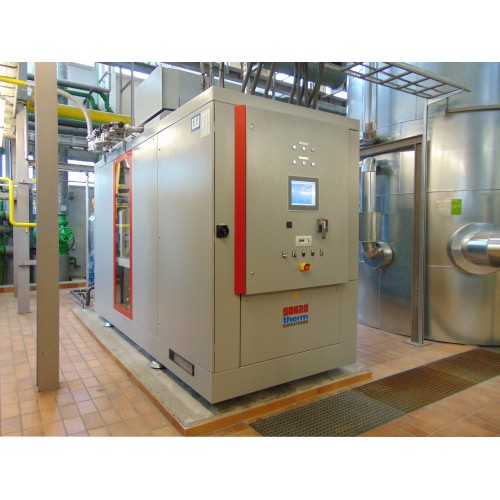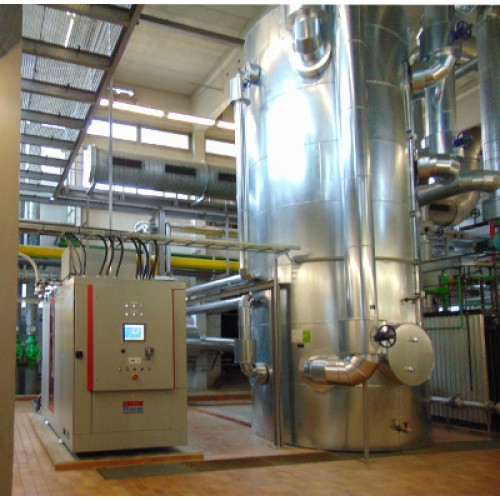Cogeneration unit Sokratherm CHP Unit GG 395
Modern cogeneration unit that produces heat and power on-site, without transport losses. Due to its high efficiency and ability to quickly turn on and off, this unit is an ideal solution for stabilizing the energy grid and balancing fluctuations in renewable energy production.
Sokratherm CHP Unit GG 395 is a modern cogeneration unit that produces heat and power on-site, without transport losses. Due to its high efficiency and ability to quickly turn on and off, this unit is an ideal solution for stabilizing the energy grid and balancing fluctuations in renewable energy production.
Cogeneration and Trigeneration: What They Are and Their Benefits
Cogeneration is the simultaneous production of heat and electricity from a single energy source, significantly increasing overall fuel efficiency. Trigeneration additionally includes the production of cooling, making this approach even more versatile and efficient.
Benefits of Cogeneration:
- High fuel efficiency.
- Reduced energy costs.
- Minimal energy transport losses.
- Quick response to demand changes.
How Cogeneration and Trigeneration Work
A cogeneration unit operates on an internal combustion engine that drives a generator. The generated electricity is used on-site or fed into the grid, while the heat produced during combustion is used for heating, hot water supply, or industrial needs. In trigeneration, the additional heat is used to produce cooling via absorption chillers.
Advantages of Cogeneration Compared to Traditional Energy Production Methods
- Higher Efficiency: Cogeneration uses up to 90% of the fuel energy, whereas traditional methods use only about 50%.
- Flexibility: The ability to quickly turn on and off allows for better response to demand changes.
- Cost Savings: Reduced energy costs and lower infrastructure expenses.
Environmental Benefits of Cogeneration and Trigeneration
- Reduced CO2 Emissions: Higher fuel efficiency results in lower greenhouse gas emissions.
- Minimized Heat Losses: Using heat that is usually wasted reduces overall fuel consumption.
- Support for Renewable Energy: Stabilizing the grid during fluctuations in renewable energy production.
CHP (Combined Heat and Power Generation): What It Is
CHP, or cogeneration, is a technology that allows simultaneous production of heat and electricity from a single fuel source. The core component of a CHP unit is an internal combustion engine that drives a generator. The electricity can be consumed on-site or fed into the grid, while the heat is used for various needs such as heating and hot water supply.
Unit Sizes
To ensure high annual utilization, cogeneration units are typically sized based on the base heat load of the facility. This approach covers a significant portion of energy consumption, often more than half of the annual heat and power needs. Peak demands are covered by public grids and peak boilers.
Control Systems
The control system for CHP units from Sokratherm ensures complete control and automation of the cogeneration units' operation. It includes real-time monitoring and control functions, maximizing the efficiency and reliability of the units.
Advantages of Sokratherm CHP Units
- Compact Design: Ideal for installation in confined spaces.
- Minimal Installation Costs: Due to ready-to-connect construction with an integrated control panel.
- High Efficiency: Optimal use of fuel energy.
- Environmental Friendliness: Operating the engine in the range with the lowest emissions.
- Low Noise Levels: Excellent sound insulation and vibration decoupling.
- Automation: Fully automatic operation with internet-based remote monitoring and control.
- Reliability: High reliability and low operating and maintenance costs.
Increasing Thermal Efficiency with Condensing Heat Exchangers
At especially low return temperatures (below approximately 50°C), it is often sensible to gain additional heat from the exhaust gases. This can increase the regular thermal power of the unit by up to 15%, raising the total efficiency by several percentage points.
Cooling in Trigeneration
Our cogeneration units can be equipped with a 'Hot Cooling' function, allowing operation at increased flow temperatures up to 95°C. This is necessary for optimal operation of absorption chillers and other processes.
Installation in Containers or Substations
For special application cases, we offer our cogeneration units in weatherproof containers or concrete blocks, allowing them to be placed outside the main buildings.
Steam Production
The heat generated by a cogeneration unit can be used to produce steam, necessary for industrial processes such as in food processing or breweries.
Emergency Power Supply
Our cogeneration units can provide emergency power by operating in island mode, supplying critical systems during a mains failure.
Buffer Heat Storage
Buffer heat storages improve the operation and profitability of cogeneration units by absorbing excess heat and providing it when needed. This enhances the efficiency and economic viability of the units.
Grid Control
The zero feed-in control ensures that the unit does not feed electricity into the public grid, adjusting production to match on-site consumption.
| Characteristic | Value |
|---|---|
| Engine type | E3262 LE232 |
| Electrical power [kW] | 397 |
| Thermal power [kW] | 505 |
| Gas consumption [kW Hi] | 999 |
| Electrical efficiency [%] | 39.7 |
| Thermal efficiency [%] | 50.6 |
| Total efficiency [%] | 90.3 |
| Power to heat ratio | 0.76 |
| Primary energy factor | 0.036 |
| Service interval [operating hours] | 1000 |
| Major overhaul after [hours] | 50000 |
| Length [mm] | 4000 |
| Width [mm] | 1500 |
| Height [mm] | 2550 |
| Operating weight [kg] | 7240 |
| Noise level [dB (A) at 1 m] | 74 |

-default-500x500.jpg)















